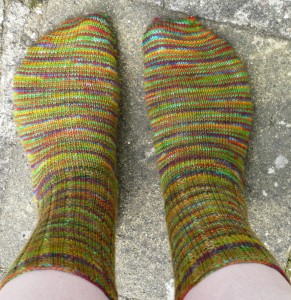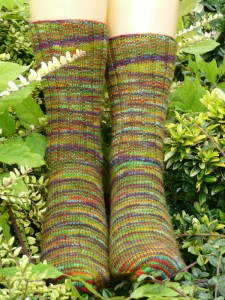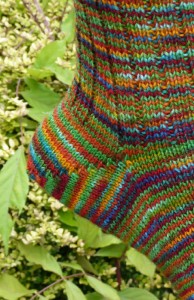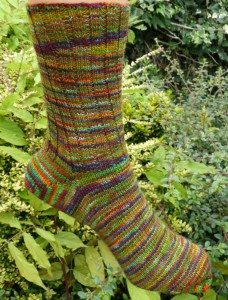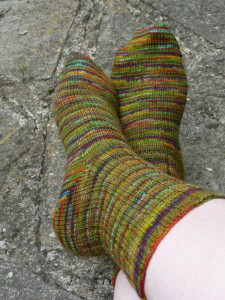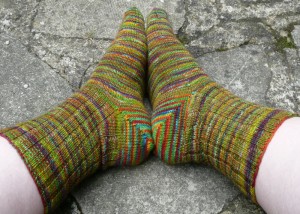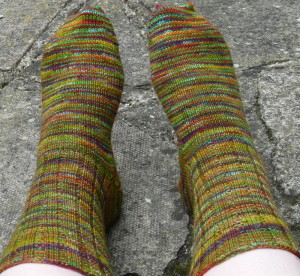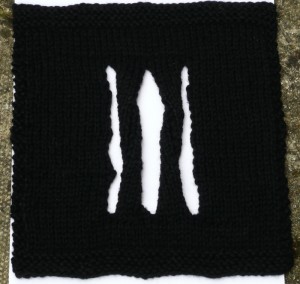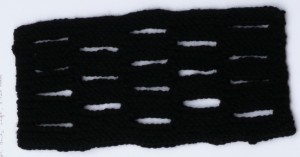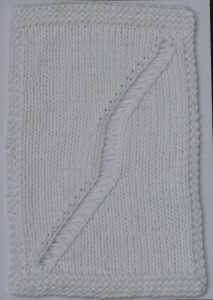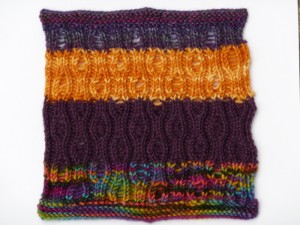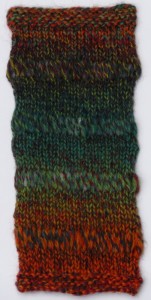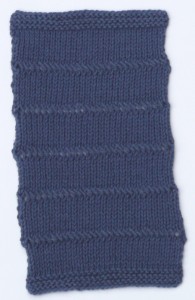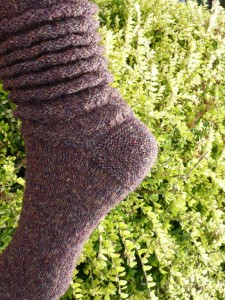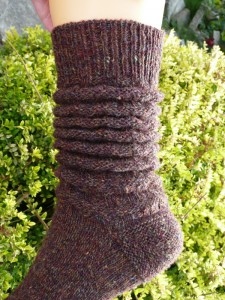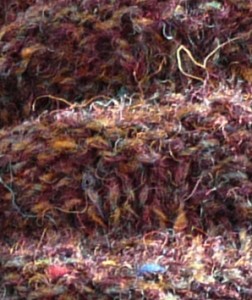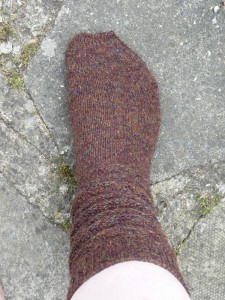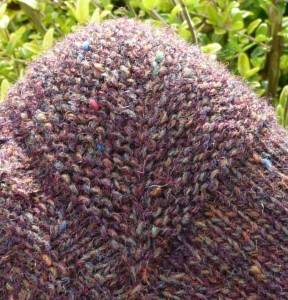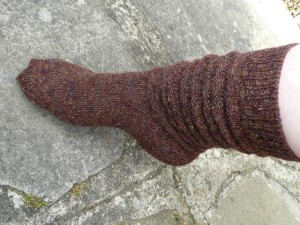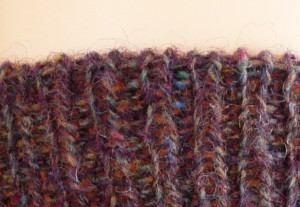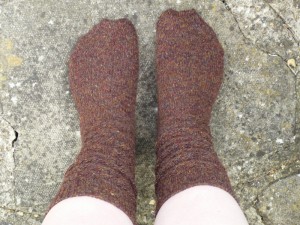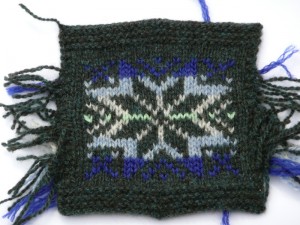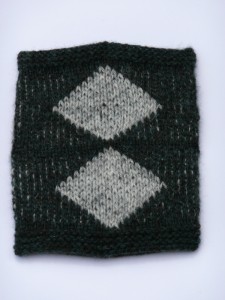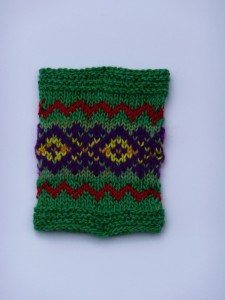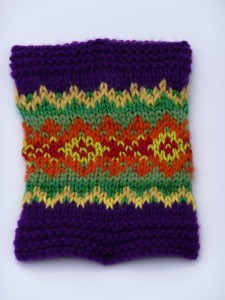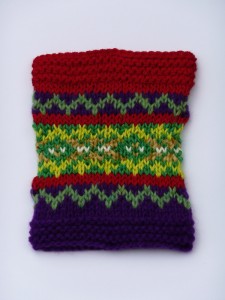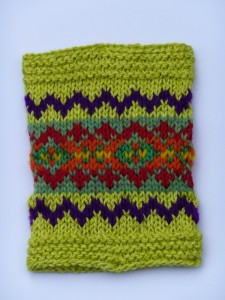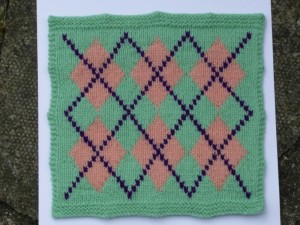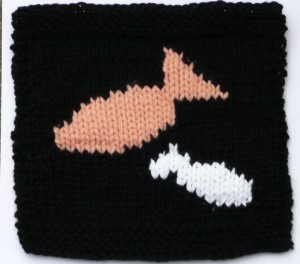After the excitement of the dyeing workshop with Jan, we couldn’t wait to get home and do some more experimenting. Since seeing the yarns Lisa from the Ash knitting group had dyed with food colouring I was very keen to have a go at that. Also I had some packets of Kool Aid picked up on a trip to America some years ago, and had bought some Jacquard acid dyes from Fibrecrafts which I was looking forward to playing with too.
We thought we would start with the least toxic and work upwards from there 🙂 Luckily when we replaced our microwave a few months ago I saved the old one (works fine, just a bit small and old, I bought it when I first went to university in 1995). So we could have a microwave dedicated to dyeing and not worry about cross contamination.
First off we soaked our yarns. I didn’t have any ammonium sulphate so we used white vinegar as a mild acid fixative. We soaked the yarn in water with a dash of washing up liquid, to remove any spinning oils and to act as a wetting agent, and a glug of vinegar for the acidity. As you can see this was a terribly precise experiment. The yarn we used this time was again blue faced leicester from H W Hammand, but this time the superwash sock weight. I tend to like to knit with finer yarns, and was interested to see how the superwash treated yarn would take up the dye. The yarn comes in 100g hanks, and we soaked two each, one for the food colouring and one for the acid dye, and soaked a hank each in plain water for the Kool Aid. The Kool Aid is already acidic so you don’t need to add extra acid.
While the yarns were soaking we mixed up the Supercook food colourings. Jan had given us a recipe of 1 tablespoon (15ml) of dye, to 2 tablespoons of water, and 1 teaspoon (5ml) of white vinegar. Using this ratio we mixed up two bottle of green food colouring, and one each of red, blue, and yellow. Each bottle contains about 3 tablespoons of liquid, so we mixed that with 6 tablespoons of water and 1 of vinegar. With the dyes all ready and waiting in disposable plastic cups, we laid out our cling film as before and arranged the damp yarn on top of it. One big advantage of this dyeing session was the opportunity it gave me to properly clean the kitchen worktops for possibly the first time since we moved in! We then covered the worktops with a folded out rubbish bag (to stop the dye dyeing the worktop) and a layer of newspaper (to mop up any spills) to create our workspace.
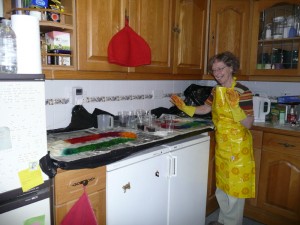
Happy dyer in action
Once we had finished painting we wrapped up our cling film parcels, put them in a nice cheap pyrex bowl bought for the purpose and nuked them in the microwave for about 2 minutes. Then let them rest for 2 minutes, followed by another 2 minutes nuking. On the second nuking the cling film parcel started to puff up showing that steam was being produced, but to be on the safe side we gave it another round of rest and heat. After the third cooking, a careful prod of the parcel showed that the liquid remaining was pretty much clear and that the dye had all be absorbed by the yarn. We left the yarn to cool down for a few hours, and went to mix the Kool Aid. Luckily the microwave is right next to the back door since the smell of boiling vinegar is quite pungent!
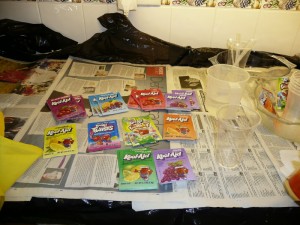
I picked up some of the Kool Aid several years ago on a trip to the states, and Paul brought me the rest back from a business trip. I was slightly worried when we first got it out (it had been lurking in one of my boxes of yarn for some years) that it might not work as the little packets had gone rather hard, but it turned out fine. After mixing up each of the sachets with a bit of water I was mystified as to why people would want to drink the stuff – the smell alone is really quite headache-inducing. I think the grape one is worst, reminds me of a kind of burnt plastic smell, not nice at all! Luckily we weren’t drinking it though, and after a few washes I am pretty sure the yarn wont smell any more.
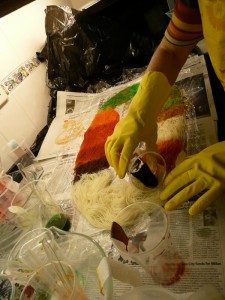
We cooked the Kool Aid dyed yarn in the same way as before and then moved on to play with the Jacquard acid dyes. I had bought 5 colours of dye to get us started, in colours which I hoped would all go well together. Blue, purple, turquoise, teal and emerald green. While I was right that they did go well together and combinations of them created other colours which also co-ordinated well, the obvious difficulty we discovered was that without any yellow or red there were a lot of colours we couldn’t create. I have rectified this now by buying yet more dye, this is looking like being as addictive as the yarn buying 🙂
We made up 1% stock solutions in each of the five colours, 5ml of dye powder to 500ml of water. We were being a bit more scientific in our experimentation at this point, I have even bought an exercise book to use as a dyeing notebook and have been writing down what we did. We then mixed some of them together, and diluted some to create paler colours, and got painting! These skeins got the same cooking treatment as the others, and then we waited impatiently for them to cool down so we could rinse them and see how it had all come out.
Unfortunately I don’t have any good photos of the yarn in skeins, I think I was too eager to wind it into balls and start knitting. It really shows the contrast though of how a yarn looks in the skein versus in a ball, and again the finished knitting. I think the ball gives more of an idea of how the knitting will come out, the colours are more mixed up than they are in the skein. I have found this before with hand dyed yarn I have bought, that I love the yarn in the skein where there are big blocks of colour but these colours look quite different when they are chopped up into lots of little pieces in the knitting. That is not to say that they aren’t nice in the knitting, just that they can often be quite different.
So onto the finished yarn, all wound into balls (I do enjoy the ball winder). First the yarn dyed with the Supercook dyes.
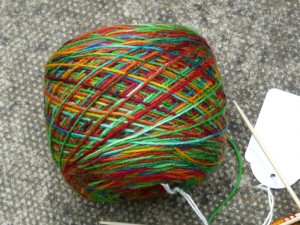
I was so impatient with this one that I have started knitting socks already.
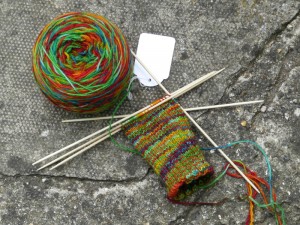
Then the Kool Aid, similar but a little different.
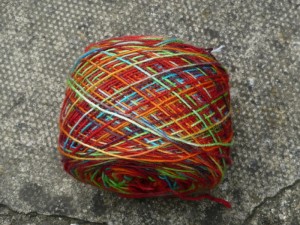
And finally the Jacquard dyed yarn.
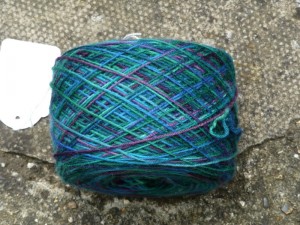
I am very pleased with how they all came out, and the dyeing itself was such a lot of fun. I am looking forward to having another session. I want to try mixing colours a bit more, and also doing different shades of the same colour which would hopefully work with more textured patterns. There are more photos of my dyeing exploits so far here, and I am hoping to add to them soon!

